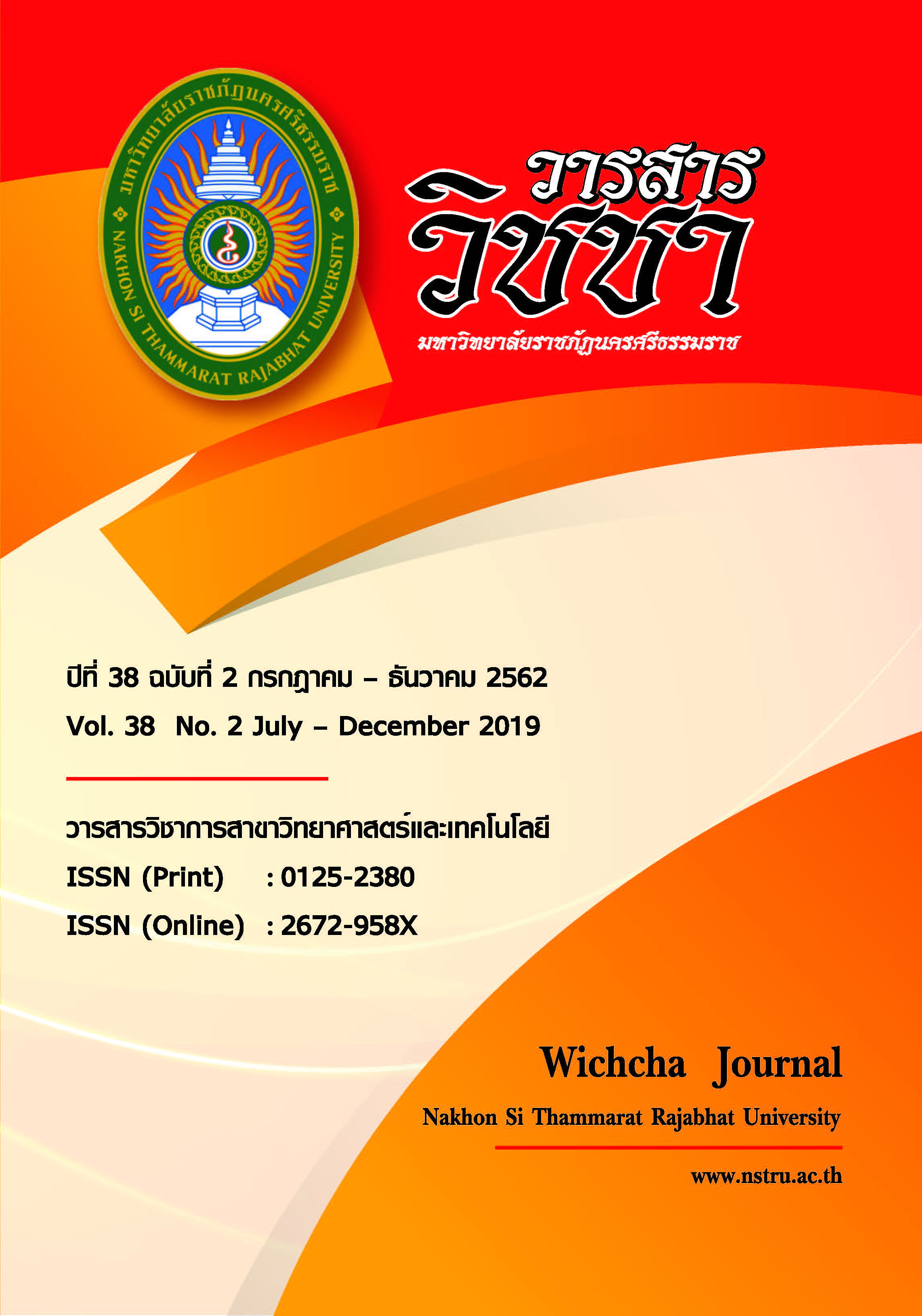Diversity of Bio-oil Freshwater Microalgae in Chi River Basin, Maha Sarakham Province ความหลากหลายของสาหร่ายน้ำจืดขนาดเล็กที่สะสมไขมันในลุ่มแม่น้ำชีจังหวัดมหาสารคาม
Main Article Content
Abstract
At present, the demand for oil is a huge source of energy according to the human population. Freshwater microalgae have the potential to produce oil better than many oil plants.Thus this research were to determine species diversity of bio-oil freshwater microalgae from twenty stations of Chi river basin in three districts (Kantharawichai, Mueang Maha Sarakham and Kosum Phisai), Maha Sarakham province. The collection of microalgae used a 10 micrometer plankton net and then took microalgae to identify species and selected five species of microalgae for bio-oil determination using Nile Red staining technique and the remaining microalgae comparable to other research. From this study found 35 bio-oil microalgae species from 5 divisions and the value of percentage of bio-oil microalgae showed 57.14, 20.00, 17.14, 5.71 and 0.00 of all bio-oil microalgae in Chlorophyta, Cyanophyta, Bacillariophyta, Euglenophyta and Chrysophyta, respectively. The most dominant microalgae was Botryococcus braunii that could find at station 1: Huai Khakang, near the Wang Nam Yen Temple, Koeng Subdistrict, Mueang District, station12: Nong Khu Water Source, Ban Don Nhong, Kham Riang Subdistrict, Kantharawichai District, and the station 20 : Huai Ban Phaeng, Ban Phaeng Subdistrict, Kosum Phisai District Mahasarakham province. In the finally, the maximum and minimum number of bio-oil microalgae species were 12 and 2 species which found at station 6 :Huai Khakang, Wat Pa Suphamit, Talad Subdistrict, Muang District, and Wang Matcha, Koeng Subdistrict, Mueang District, Maha Sarakham Province. This research has not been reported before. It is useful for the source of oil microalgae in commercial culture.
Article Details
เนื้อหาและข้อมูลในบทความที่ลงตีพิมพ์ในวารสารวิชชา มหาวิทยาลัยราชภัฏนครศรีธรรมราช ถือเป็นข้อคิดเห็นและความรับผิดชอบของผู้เขียนบทความโดยตรง ซึ่งกองบรรณาธิการวารสารไม่จำเป็นต้องเห็นด้วยหรือร่วมรับผิดชอบใด ๆ
บทความ ข้อมูล เนื้อหา รูปภาพ ฯลฯ ที่ได้รับการตีพิมพ์ในวารสารวิชชา มหาวิทยาลัยราชภัฏนครศรีธรรมราช ถือเป็นลิขสิทธ์ของวารสารวิชชา มหาวิทยาลัยราชภัฏนครศรีธรรมราช หากบุคคลหรือหน่วยงานใดต้องการนำข้อมูลทั้งหมดหรือส่วนหนึ่งส่วนใดไปเผยแพร่ต่อหรือเพื่อการกระทำการใด ๆ จะต้องได้รับอนุญาตเป็นลายลักษณ์อักษรจากวารสารวิชชา มหาวิทยาลัยราชภัฏนครศรีธรรมราชก่อนเท่านั้น
The content and information in the article published in Wichcha journal Nakhon Si Thammarat Rajabhat University, It is the opinion and responsibility of the author of the article. The editorial journals do not need to agree. Or share any responsibility.
References
ภาณินี จรุงกีรติวิมล จารุวรรณ ชลสงคราม วีระสิทธิ์ สรรพมงคลไชย สุมัลลิกา โมลากุล และ
ประมุข ภระกูลสุขสถิต. (2559). การเปรียบเทียบการเจริญและการผลิตลิพิดระหว่าง Ankistrodesmus sp. IFRPD No. 1061 และ Chlorella sp. IFRPD No. 1092 ในบ่อเปิดแบบรางคู่. ใน การประชุมทางวิชาการของมหาวิทยาลัยเกษตรศาสตร์ ครั้งที่ 54 (หน้า 1004-1011). กรุงเทพฯ: มหาวิทยาลัยเกษตรศาสตร์.
ยุวดี พีรพรพิศาล. (2556). สาหร่ายน้ำจืดในประเทศไทย. (พิมพ์ครั้งที่ 2). เชียงใหม่: โชตนาพริ้นท์ จำกัด.
ลัดดา วงศ์รัตน์. (2540). คู่มือการเลี้ยงแพลงก์ตอน. (พิมพ์ครั้งที่ 1). กรุงเทพฯ: มหาวิทยาลัย เกษตรศาสตร์.
ศิวคุปต์ ธัญญเจริญ รัตนชัย ไพรินทร์ และทรงพล ชื่นคำ. (2556). การศึกษาการสกัดน้ำมันจากสาหร่าย Spirogyra sp. ผลิตเป็นไบโอดีเซลเพื่อเป็นพลังงานทดแทน. วิทยาศาสตร์เกษตร, 44(2 พิเศษ), 349-352.
สถาบันวิจัยและพัฒนาพลังงานนครพิงค์ มหาวิทยาลัยเชียงใหม่. (2554). สาหร่ายน้ำมัน: น้ำมันในอนาคต!. สืบค้นเมื่อ 24 สิงหาคม 2562, จาก:https://www.erdi.cmu.ac.th/index.php
/article/515?category=14.
สถาบันวิจัยวิทยาศาสตร์และเทคโนโลยีแห่งประเทศไทย (วว.). (2554). โครงการสำรวจสถานภาพพื้นที่ชุ่มน้ำประเภทหนองบึงน้ำจืดของประเทศไทย. กรุงเทพฯ.
สุนีรัตน์ เรืองสมบูรณ์ ศักดิ์ชัย ชูโชติ ปวีณา ทวีกิจการ และมณฑล แก่นมณี. (2555). การคัดเลือกสายพันธุ์และการเพาะเลี้ยงสาหร่ายที่มีไขมันสูงแบบมหมวลเพื่อความเป็นไปได้ในการ ผลิตเชื้อเพลิงชีวภาพ. ได้รับทุนสนับสนุนงานวิจัยจากเงินงบประมาณแผ่นดิน ประจำปี งบประมาณ 2555. สถาบันเทคโนโลยีพระจอมเกล้าเจ้าคุณทหารลาดกระบัง.
อรพรรณ พรหมธนพันธ์ และรัฐภูมิ พรหมณะ. (2556). น้ำมันชีวภาพที่สกัดจากไซยาโนแบคทีเรียและสาหร่ายสีเขียวบางชนิดที่พบในจังหวัดพะเยาและจังหวัดน่าน. นเรศวรพะเยา, 6(2), 96-99.
Abdo, S.M., Ahmed, E., El-Enin, S.A., El Din, R.S., Diwani, G.E. and Ali, G. (2014). Qualitative and quantitative determination of lipid content in microalgae for biofuel production. Journal of Algal Biomass Utilization, 5(3), 223-228.
Abishek, M.P., Patel, J. and Pajin, A.P. (2014). Algae oil: a sustainable renewable fuel of future, Biotechnology Research International, 2014.,(1)1-8
Becker, E.W. (1994). Microalgae: Biotechnology and Microbiology. Experimental Agriculture.London: Cambridge University Press.
Bold, H.C. and Wynne, M.J. (1978). Introduction to the algae. Structure and reproduction. New Delhi: Prentice hall of india private limited.
Boni, J., Aida, S. and Leila, K. (2018). Lipid extraction method from microalgae Botryococcus braunii as raw material to make biodiesel with soxhlet extraction. Journal of Physics, 1095(1). 012004.
Chen, W., Zhang, C., Song, L., Sommerfeld, M. and Hu, Q. (2009). A high throughput Nile red method for quantitative measurement of neutral lipids in microalgae. Journal of Microbiological Methods, 2009(77), 41-47.
Chisti, Y. (2007). Biodiesel from microalgae. Biotechnology Advances, 2007(25), 294-306.
Dehaghani, A.H.S. and Pirouzfar, V. (2018). Investigation on the effect of microalgae Chlorella sp. and Spirulina on biodiesel production. Petroleum Chemistry, 58(8), 702-708.
Dilia, P. and Leila, K. (2018). Fatty acids from microalgae Botryococcus braunii for raw material of biodiesel. Journal of Physics, 1095(1). 012010.
Graham, L.E., Graham J. M. and Wilcox, L.W. (2009). Algae. (2nd ed). California, USA: Benjamin Cummings.
Gusbeth, C.A., Eing, C, Göttel, M, Sträßner, R. and Frey, W. (2016). Fluorescence diagnostics for lipid status monitoring of microalgae during cultivation. Journal of Renewable Energy & Biofuels, 2016(1), 1-12.
Magdalena, F., Stefania, J. and Tys, J. (2010). Microalgae for biofuel production and environmental applications: a review. African Journal of Biotechnology, 9(54), 9227-9326.
Metzger, P. and Largeau, C. (2005). Botryococcus braunii: a rich source for hydrocarbons and related lipids. Applied Microbiology and Biotechnology 66(5), 486-496.
Nascimento, A.I., Marques, S.S.I., Cabanelas, I.T.D., Carvalho, G.C., Nascimento, M.A., Souza, C.O., Druzian, J.I., Hussain, J. and Liao, W. (2014). Microalgae versus land crops as feedstock for biodiesel: productivity, quality, and standard compliance. BioEnergy Research, 7(3), 1002-1003.
Patel, V.K., Sundaram, S., Patel, A.K. and Kalra, A. (2017). Characterization of seven species of cyanobacteria for high-quality biomass production. Arabian Journal for Science and Engineering, 43(1), 109-121.
Prasertsin, T. and Peerapornpisal, Y. (2018). Distribution and isolation of microalgae for lipid production in selected freshwater reservoirs of northern Thailand. Biodiversitas, 19(1), 343-350.
Rattanapoltee, P. and Kaewkannetra, P. (2013). Nile red, an alternative fluorescence method
for quantification of neutral lipids in microalgae. Journal of Biotechnology and Bioengineering, 7(9), 889-893.
Unpaprom, Y., Tipnee, S. and Rameshprabu, R. (2015). Biodiesel from green alga Scenedesmus acuminatus. International Journal of Sustainable and Green Energy, 4(1-1), 1-6.

